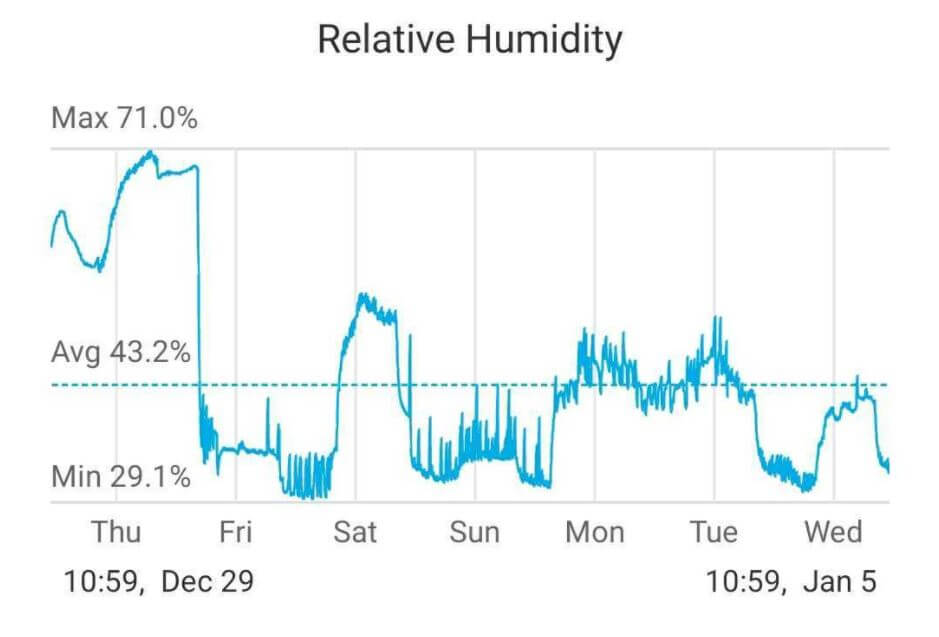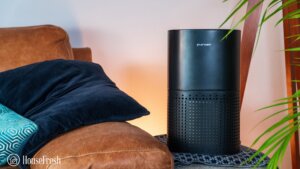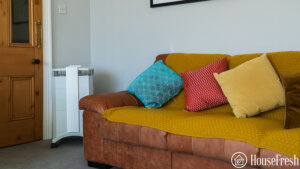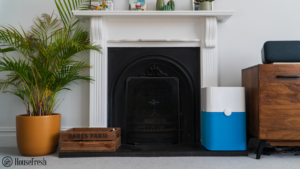The main use case for this dehumidifier was to keep my growing tent free of excess humidity – I didn’t want to have something that took a lot of space but I also needed a unit that I could trust to deal with a large amount of humidifier as it would be located in our basement.
I will be honest, DeLonghi is not a brand I expected to run into in regards to dehumidifiers, as they are normally known for their coffee machines. But I read about the company and learned that they have significant history manufacturing heaters and air conditioners, so it makes total sense that they would move into the world of dehumidification.
As with all our hands-on reviews here at HouseFresh, I bought this unit with my own money, so I have no biases to give a better review than I would under normal circumstances. I also completed a series of tests in my own basement to assess the performance of the De’Longhi DEX214F in real-life conditions.
- We set the dehumidifier up to run in a Gorilla Grow Shorty Grow tent (3ft x 3ft) placed in the most humid area of my basement.
- With the help of a Govee WIFI humidity sensor, we track the dehumidifier’s performance over time, recording humidity levels every hour.
- We plug in the dehumidifier through an electricity usage monitor to measure precisely how much electricity is used when running the unit at the lowest and highest speed settings.
- We track sound levels emitted by the dehumidifier at different fan speeds with the help of a commercial sound meter.
- We export all this data and visualize it using Flourish to clearly show changes in humidity and energy consumption over time compared to other appliances.
Right, let’s break down my first-hand experience using the De’Longhi DEX214F dehumidifier. I have been using this unit since September 2021, so I feel confident to give both a short-term and medium-term review of my experience.
The lowdown on the De’Longhi DEX214F


What we really like
What we think could be better
The specifications
| HouseFresh Rating: | ★★★★☆ |
| Water it can remove in a day: | 14 liters (you can also get a 12-liter and a 16-liter option) |
| Recommended room size: | 247 sq. ft. (23 mᶟ) |
| Water tank capacity: | 2.1 liters |
| Dimensions (in inches / in cm): | 8.6D x 13.1W x 19.6H inches (22D x 33.4W x 50H cm) |
| Weight (in pounds / in kg): | 24.9 lbs (11.3 kg) |
| Noise levels: | 40 dB max |
| Other features: | All three sizes come with a continuous hose. Recommended for those looking to keep their humidifier running all the time. |
| Warranty: | 2 years |
Clean design lines in a compact size
I know that looks are not the main focus for most people but it is something we like to assess when we know that a unit is going to be in a room all the time.

The Italian heritage is clear with this dehumidifier. The design of the De’Longhi DEX214F is a lot more aesthetically pleasing than most dehumidifiers we have tested.
With its pearly white color and curves, the DEX214F breaks the mold used by other manufacturers who tend to release boxy dehumidifiers that are heavy and difficult to maneuver.
The handle is built into the main part of the unit, making it easy to move the dehumidifier from room to room if you need to do it. This is made even easier thanks to the low weight of this dehumidifier (only 24.9 lbs/11.3 kg when the tank is empty).
Unlike bigger units, it does not include a wall mount, so you can only use your De’Longhi DEX214F in cases where you have space to place it on the floor.
I doubt anyone is going to buy this dehumidifier for looks alone, but it is great to see the care De’Longhi took to make this unit look good when compared to the competition.
Another aspect of design that I always like to review is the control panel. After using the DEX214F at home for over six months, I am happy to report that this is one of the simplest units I have come across in terms of menu options.

💧💧💧 Approximately 40% environment humidity
💧💧 Approximately 50% environment humidity
💧 Approximately 60% environment humidity
The DEX214F also comes with a DRY mode 👕, which is very handy for speeding up the drying of laundry as it sets the dehumidifier to run at its top speed for a short period of time.
You will also get two indicator lights: one to let you know when the tank is full and another one to indicate that the room temperature is too low so the unit is operating at low-temp to ensure the dehumidifier doesn’t ice up.
If you’ve never used a dehumidifier before, these controls will be simple enough to ensure you can just switch on your unit and forget about it – until it’s time to empty the water tank at least!
Underwhelming double filtration technology
I would never recommend you use a dehumidifier to clean the air in the room as an air purifier will always be a better appliance for that specific job. That said, I was happy when I read that the De’Longhi DEX214F came with a double filter system as air filtration technology should keep out particulate matter that might damage the parts inside the unit.
The double filter in the DEX214F is comprised of a dust filter and a replaceable allergen filter for picking up smaller particles.

The dust filter is fine and covers the entire air intake but I wasn’t impressed with the allergen filter.
The problem is that the “allergen filter” is very very small and only protects the air coming from one section of the air intake, so it is basically useless.

Overall this was one of the weakest areas for this particular dehumidifier. I hope that De’Longhi looks at a more effective allergen filter for future models, such as the large filters used in British-made Ebac dehumidifiers.
The De’Longhi DEX214F lowered humidity levels in our test tent within 10 minutes
As I briefly explained earlier in this review, I ran three tests on the De’Longhi DEX214F in my basement to assess its performance in real-life conditions.
The first test was the dehumidification performance test, where I ran the DEX214F inside a Gorilla Grow Shorty Grow tent (3ft x 3ft) placed in the most humid area of my basement.
In the graphic below, you can see how quickly the humidity was reduced after switching on the dehumidifier:

It took less than 10 minutes to reduce from 71% to under 30% relative humidity, which is to be expected in a small space but still impressive to see. By the way, I used a Govee Wifi hygrometer to measure the temperature and humidity levels. What I like about this device is that you set it and then easily pull data in one-minute intervals.
In the graph above, you can see how effective the onboard humidity detector is. You will see that the sensor detected rising humidity levels, and once they hit a high level (60%), the DEX214F automatically switched on to full power till humidity levels dropped.
Every time humidity levels exceeded the average, the onboard humidity detector picked up those levels and switched on the unit until the desired humidity was reached.
It’s worth mentioning that this is a test we have designed to test humidifiers in a controlled space (our grow tent). It is a small space, and most people wouldn’t even consider using a dehumidifier inside a tent, but in terms of our testing, I was pleasantly surprised by the dehumidification performance of the DEX214F.
The only downside was remembering to remove the water, as the 1.2L bucket gets filled pretty quickly in very humid conditions, and my basement is ridiculously humid.
Noise levels test results
When running at its top mode, the De’Longhi DEX214F hit a maximum of 40 dB. This is equivalent to a refrigerator humming in the background.
We’ve recorded a video where we take the dehumidifier from mode to mode so you can listen to the associated noise levels with your own ears, as I understand that noise levels are a personal thing.
The cost to run a De’Longhi DEX214F: $206.04 per year
As part of my testing, I used a power meter to see how much power was used when the dehumidifier was on standby mode (not actively removing water) and found that it used 1.5W (left), which is around $2.1 per year, assuming the average utility rate in the U.S. of $0.12/kWh.

Once the dehumidifier detects an increase in humidity, it will go into full power mode, and as you can see in the image to the right, it increased to 195.6W, which is $206.04 per year (U.S. average utility rate of $0.12/kWh).
The reality is that most people won’t need to run their dehumidifier non-stop for 24 hours a day every single day of the year. But by looking at these figures, you can clearly see the financial benefit of an automatic system that reduces usage when the humidity target is reached.
Bottom line
If you are looking for a premium dehumidifier for a small to medium-sized room and you are based in the European region, you can’t wrong with the De’Longhi DEX214F.
It’s not without its faults, such as the tiny “allergen filter” but these cons are minor when weighed in the context of this unit’s performance. The power of this dehumidifier more than makes up for these minor issues.

De’Longhi is not a company name I would have connected to powerful dehumidifiers, but now that I have tested one of their units firsthand, I am impressed. I would be interested in future models from this company, and I have high expectations for its long-term usage. I do hope they make these dehumidifiers available in America soon.
SOURCES
We calculated the monthly energy consumption costs with the help of the Department of Energy’s appliance energy calculator. We calculated yearly costs associated with running the De’Longhi DEX214F. for 24hs a day for 365 days. We ran this calculation utilizing the U.S. average utility rate of $0.12/kWh as of August 8th, 2023.







